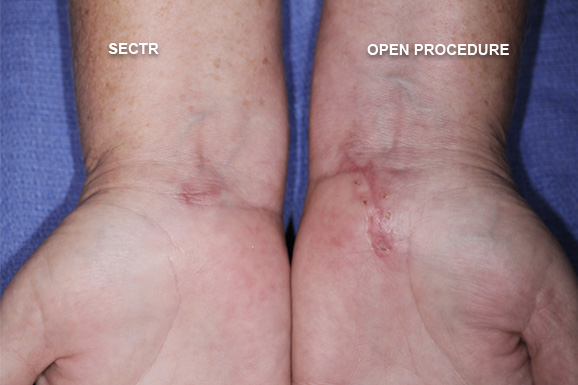Carpal Tunnel Syndrome Doctor in Dallas
What is Carpal Tunnel Syndrome?
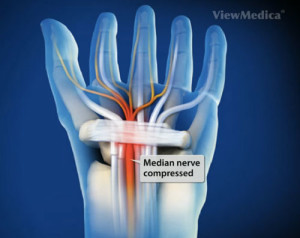 The carpal tunnel of the wrist is a confined space which surrounds the median nerve. The bottom, or dorsal side of the tunnel consists of the wrist bones, while the top, or palmar, side of the tunnel is defined by the transverse carpal ligament. Nestled in this small space are tendons responsible for movement of fingers and the median nerve surrounded by synovial fluid. The median nerve is responsible for sensation in the thumb, index, and middle finger and half of the ring finger on the affected hand, as well as motor function muscles at the base of the thumb that allow the thumb to oppose to the fingers. Carpal Tunnel Syndrome is caused by pressure on the median nerve, resulting in numbness, tingling, and weakness in the hand and arm.
The carpal tunnel of the wrist is a confined space which surrounds the median nerve. The bottom, or dorsal side of the tunnel consists of the wrist bones, while the top, or palmar, side of the tunnel is defined by the transverse carpal ligament. Nestled in this small space are tendons responsible for movement of fingers and the median nerve surrounded by synovial fluid. The median nerve is responsible for sensation in the thumb, index, and middle finger and half of the ring finger on the affected hand, as well as motor function muscles at the base of the thumb that allow the thumb to oppose to the fingers. Carpal Tunnel Syndrome is caused by pressure on the median nerve, resulting in numbness, tingling, and weakness in the hand and arm.
Carpal Tunnel Syndrome Symptoms
The presentation of Carpal Tunnel Syndrome’s symptoms varies from person to person but almost always includes wrist pain. The wrist pain is typically worse at night and frequently causes night time awakening. Other symptoms of Carpal Tunnel Syndrome include numbness, burning and tingling sparing the little finger, clumsiness, reduced grip strength, and weakness. Other, less common symptoms include writer’s cramp, shoulder pain, or even numbness in the third finger alone. If you think you may be experiencing symptoms of Carpal Tunnel Syndrome, it’s important to get an appointment with an orthopedic hand specialist as soon as possible.
Causes of Carpal Tunnel Syndrome
 While the causes of CTS are not fully understood, multiple risk factors have been associated with the condition. These risk factors include, but are not limited to:
While the causes of CTS are not fully understood, multiple risk factors have been associated with the condition. These risk factors include, but are not limited to:
Repetitive Movements & Overuse
Inflammation of the tendon sheaths is the most recognizable factor associated with Carpal Tunnel Syndrome. Inflammation may occur with overuse of the wrist, repetitive movements of the wrist, or high force or high pressure movements of the wrist. Occupations and hobbies requiring the use of vibratory instruments are also high risk for Carpal Tunnel Syndrome.
Swelling in the Body
Swelling in the body may result in an increase in the volume of fluid in the carpal tunnel, causing compression of the median nerve. Pregnancy and Congestive Heart Failure are two conditions associated with CTS for this reason.
Sex
Women are three times more likely to develop Carpal Tunnel Syndrome than men. This is largely due in part to the fact that women tend to have smaller carpal tunnel areas than men, but can also be associated with fluid retention due to hormonal changes.
Tumors or Growths
Tumors and other growths can take up space in the carpal tunnel resulting in compression of the median nerve.
Anatomic Factors
A wrist fracture or dislocation, a hand or wrist deformity, or thickening of the tendons can alter the space within the carpal tunnel and put pressure on the median nerve. Additionally, people who have smaller carpal tunnels are at a higher risk of carpal tunnel syndrome.
Inflammatory Conditions
Conditions that cause an inflammatory response, such as rheumatoid arthritis, can affect the lining around the tendons in the carpal tunnel and put pressure on the median nerve.
Medications
Studies have shown a link between Carpal Tunnel Syndrome and the use of certain medications, including aromatase inhibiting antiestrogens, diphosphonates, oral anticoagulants, and some antiretrovirals.
Nerve Damaging Conditions
Conditions such as diabetes or alcoholism, which are known to have direct cytotoxic effects on nerve cells, can damage the median nerve directly, complicating the other causes of CTS.
Diagnosing Carpal Tunnel Syndrome
Patient History
The first step in diagnosing Carpal Tunnel Syndrome is taking a careful and detailed patient history, looking at the potential risk factors at hand. Your provider will review your symptoms, their severity, how long you’ve been experiencing them, the times at which they are the worst, and more. This is important as Carpal Tunnel symptoms commonly occur at night and can cause numbness upon waking in the morning.
Physical Examination
In addition patient history, your provider will perform a physical examination. The physical exam is used to gauge your hand sensation and strength and looking for any key symptoms such as tenderness at the wrist and distal forearm, swelling at the distal forearm, diminished sensation or feeling to all fingers, and muscle weakness. The physical examination may include a few specific tests, such as:
- Tinsel’s Test: Tinel’s test is performed by thumping, or tapping, the skin over an irritable nerve or wrist crease. If Carpal Tunnel Syndrome is present, this test will cause a feeling of tingling – commonly referred to as “pins and needles”.
- Phalen’s Test: Phalen’s test is a provocative wrist flexion test, performed by manually flexing the wrist to a 90 degree angle. If Carpal Tunnel Syndrome is present, symptoms with will produced within 60 seconds.
Electromyography
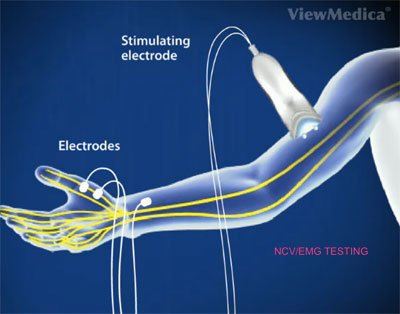
Electrodiagnostic testing is a cornerstone of any thorough Carpal Tunnel diagnostic work up. Electromyography, as illustrated in this video, is used to determine the health of the muscle and nerves in the wrist and hand. This test is performed by inserting a thin needle electrode into certain muscles to evaluate the electrical activity that occurs when the muscles contract and rest. This test can note when muscles controlled by the median nerve are damaged and also helps to rule out other conditions with similar symptoms.
Nerve Conduction Study
In a typical nerve conduction study, two electrodes are taped to the skin, and a small shock is passed through the median nerve. The function of the median nerve is then compared to the function of a similar nerve that does not pass through the carpal tunnel, usually the radial or ulnar nerve. In patients with Carpal Tunnel Syndrome, the electrical impulses are slowed along median nerve.
Imaging
Ultrasounds and MRIs are useful adjunctive tests to gather additional information if the nerve conduction test is equivocal or negative and a high degree of suspicion exists for CTS. Additionally, X-Rays are often used to rule out other causes of wrist pain, such as a fracture or arthritis.
Carpal Tunnel Syndrome Treatments
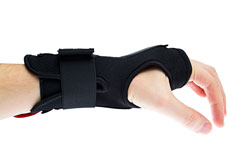 Treatment for Carpal Tunnel Syndrome depends on the severity of the symptoms and disability and includes both surgical and nonsurgical interventions. Non-surgical treatment of Carpal Tunnel Syndrome may consist of immobilization by hand brace or splinting, ultrasonic therapy, oral steroids, injections, NSAIDS, and workplace modifications, tailored to the individual’s needs.
Treatment for Carpal Tunnel Syndrome depends on the severity of the symptoms and disability and includes both surgical and nonsurgical interventions. Non-surgical treatment of Carpal Tunnel Syndrome may consist of immobilization by hand brace or splinting, ultrasonic therapy, oral steroids, injections, NSAIDS, and workplace modifications, tailored to the individual’s needs.
Surgery is indicated for moderate to severe cases of Carpal Tunnel Syndrome, or when CTS is unresponsive to non-surgical interventions. Surgery for CTS involves cutting the transverse ligament of the carpal tunnel to relieve pressure and alleviate symptoms. It can be done effectively by either the traditional open release procedure or by the newer endoscopic procedure.
Open Release Procedure
In the traditional open method, a three inch incision is made on the wrist to allow the surgeon to directly visualize the carpal tunnel and surrounding structures, and to allow manipulation with traditionally sized instruments. When the procedure is completed, the wound must be sutured and a splint worn for up to three weeks following. Physical therapy is often needed to complete the healing process, and return to work may be delayed for three months.
Endoscopic Procedure
In contrast, technological advances have made it possible to release the transverse ligament endoscopically. In Stitchless Endoscopic Carpal Tunnel Release (SECTR) a much smaller incision is made, and with the aid of a tiny camera to visualize the carpal tunnel and surrounding structures, a thin probe is used to divide, or cut, the transverse ligament. Following SECTR no sutures are needed. The wound is bandaged with waterproof material that allows bathing and self care. The scar is smaller, with reduced scar tenderness. Return to light activities is immediate, physical therapy is usually not needed, and most return to strenuous work after a month.
What is Endoscopic Carpal Tunnel Release (ECTR)?
ECTR is the most advanced method to treat Carpal Tunnel surgically. We refer to ECTR as SECTR as there are no stitches. It’s a revolutionary procedure that should replace the older method called Open Procedure. In this page we will outline the benefits of ECTR and compare to the antiquated Open Procedure. To put it simply, ECTR or SECTR is more advanced and beneficial in every way.
Endoscopic Carpal Tunnel Release (ECTR)
- Stitchless 10 minute surgery
- Minimal scarring and pain with 1 cm incision
- No restrictions after 48 hours
- One week recovery
- Indicated as early as 8 weeks after symptom onset to prevent permanent nerve damage
- 50% faster recovery than the “open” procedures
Endoscopic Carpal Tunnel Release (ECTR) Procedure

1. Preparation: A small incision is created in the wrist.
2. Endoscope Inserted: An endoscope, which the surgeon uses to see inside the wrist and hand, is inserted underneath the transverse carpal ligament. The endoscope has a light and a small video camera that sends images to a TV monitor in the operating room.
3. Ligament Cut: Using the video images from the endoscope as a guide, the surgeon precisely cuts the constricting transverse carpal ligament, relieving pressure on the median nerve.
Note: Through a single, small incision, the ligament is released without having to cut through the skin and muscles of the palm resulting in less pilar pain and less scarring pain.
| Endoscopic Carpal Tunnel Release (ECTR) | Open Procedure (Older Method) |
| Stitchless surgery that takes less than 10 minutes. | 5-10 sutures |
| 1/4 inch scar that is a fraction of the size of any other carpal tunnel release method. | 3 inch scar |
| Little to no scar sensitivity. Additionally, the scar is less tender and heals much quicker. | Tender scar for months, possible permanent |
| Small dressing | Splint for 3 weeks |
| May get dressing wet | Must keep dry for 3 weeks |
| Usually no therapy | 4-8 weeks of therapy |
| Light activities Immediately | Light activities at 3 weeks |
| Return to strenous work at 1 month | Return to strenous work at 3 months |
Dr. Knight Performs SECTR Procedure
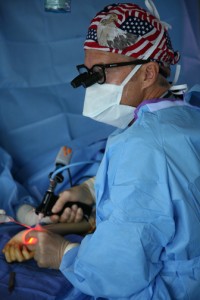
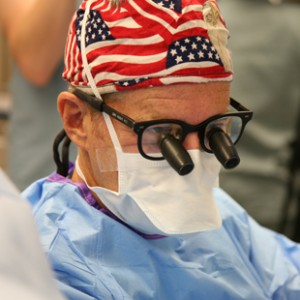
Testimonials
“A recent experience with the extreme pain of carpal tunnel syndrome sent me running to find help. Dr. Knight’s office really came to the rescue. They saw me within an hour of my call. A very competent and professional staff greeted me and escorted me to a room where a technician carefully arranged my hand for a series of x-rays. Within minutes Dr. Knight introduced himself and explained the problem and the surgical solution. An MRI was required for optimal information. Dr. Knight’s office set up that appointment and then scheduled the surgery. Dr. Knight’s thoughtful and pleasant manner should be a measure for all doctors. I am happy to report that, three weeks later, I have full use and strength in my hand. Throughout the healing process, the office was fully attentive to my needs and concerns. Dr. Knight and his staff could not have been more professional and caring. My thanks to Evelyn, Katie and, of course, the good doctor.”
Michael Durrell (Actor)
Dear Dr. Knight and staff,
My name is Suzanne Olah-Macek and I recently had carpal tunnel surgery (March 4th, 2013) on my right wrist at The Hand and Wrist Institute.
Carpal tunnel was a condition I had struggled with for many months, but since I work as an Occupational Therapist using my hands I was nervous about the procedure. Just scrolling the information on his website thehandandwristinstitute.com gave me all the information I needed to agree to an appointment (especially the videos of the actual procedure and recovery times). This was the first surgery I have ever had and the staff made my stay very relaxing and comfortable.
I would like to express my sincerest gratitude and appreciation for the professionalism and excellent care I received in Dr. Knight’s offices, during my examination, the actual surgery, and when I returned for aftercare. I never had problems reaching the staff when I had questions, and they were always prompt when returning my calls. Their reminder calls for appointments were especially helpful as was the ease of filling out the important information forms online.
The recovery time was faster than other recovery times I had heard of, and I was back to work within a week (with light duty of course). It has been two and a half months since my surgery and I feel great. My numbness, tingling, and pain has almost completely disappeared and I am working my regular employment duties. My life is much more manageable especially since the pain has disappeared.
I would highly recommend Dr. Knight and his staff for any hand, wrist, or upper extremity injuries you might be facing. Thank you once again for the wonderful service.
With Gratitude,
Suzanne Olah-Macek
MA, COTA
Department of Developmental Services Fairview Developmental Center Physical Medicine and Rehabilitation
Occupational Therapy Department
How can Dr. Knight help you with carpal tunnel syndrome?
Carpal Tunnel Syndrome is one of the most common upper extremity afflictions that Doctor Knight treats. We believe Dr. Knight to be the foremost expert on Carpal Tunnel Release in Dallas, Texas. After decades of practice, he has effectively treated tens of thousands of patients who suffer from this condition. With the prevalence of the condition, and the sheer volume of patients that Dr. Knight sees, the effective resolution of Carpal Tunnel Syndrome is one of Dr. Knights proudest achievements. Every successful case is a personal triumph in the battle against it. Dr. Knight is one of the foremost carpal tunnel specialists in the country. With two Dallas Fort-Worth friendly locations in Southlake and Dallas, we welcome all Texas patrons as well as out of town patients. Contact us to set up an initial consultation today.
Carpal Tunnel Syndrome Fact Sheet
| How can I get Carpal Tunnel Syndrome? | Carpal Tunnel Syndrome is caused mostly by overuse, which leads swelling of vessel encasing the nerve as it passes through the eponymous carpal tunnel. |
| How painful is Carpal Tunnel Syndrome? | Because it is a nerve-related injury, Carpal Tunnel does have sensory effects, but they are generally numbness and tingling, and not pain, until the condition advances and, and then pain can be a side effect. |
| Can Carpal Tunnel syndrome be cured? | "Cure" is a loaded term, but Carpal Tunnel syndrome can absolutely be treated effectively. If caught early enough, and steps are taken to modify the circumstances that lead to the development of symptoms, then the development of the condition can be avoided entirely, but even after it develops, conservative or surgical treatment offer very good results, and the sheer volume of cases that doctors see every day means that a great deal of research and practice have gone into the successful treatment of Carpal Tunnel syndrome. |
| Can Carpal Tunnel Syndrome be treated at home? | The most effective at-home treatments for Carpal Tunnel syndrome are rest, icing, and ergonomics, along with anti-inflammatory medications |
| Medications for Carpal Tunnel Syndrome | Medications used to treat Carpal Tunnel syndrome include oral steroids, steroid injection, and NSAIDs |
Carpal Tunnel Syndrome Frequently Asked Questions
What happens if I don’t get my Carpal Tunnel Syndrome treated?
Carpal Tunnel Syndrome is a condition that can come in many forms, from light to severe, and while it may start out as only a minor annoyance, if it is left untreated, it can escalate into a serious condition that will affect your motor skills and cause intense pain that can make even the simplest of daily tasks absolute agony.
Can Carpal Tunnel Syndrome be cured?
Through effective treatment, either conservative or surgical, the effects of Carpal Tunnel Syndrome can be significantly lessened or removed entirely, yes.
How bad can Carpal Tunnel Syndrome really be?
Even if it starts off as nothing more than a slight tingling, Carpal Tunnel Syndrome is strongly affected by the amount of usage that your wrists and hands see on a daily basis, so it can quickly spiral into a much more painful condition than it first appears. Discomfort may not be the end of the world, but the very real pain that can develop at the more advanced stages of the condition will definitely make you wish you had sought treatment sooner rather than later.
Is surgery for Carpal Tunnel Syndrome really necessary?
As with most conditions, Carpal Tunnel Syndrome can be treated in a variety of ways, and surgery is just one of those options. In many cases, surgical intervention is not necessary, and modifications of work environment, the use of ergonomics, and a lightening of use of the hands are enough to reduce the discomfort associated with Carpal Tunnel Syndrome to a manageable level or entirely. At more severe stages of the condition, however, surgery is the only way to effectively remove the actual issues within the carpal tunnel itself and stop the pain. So, no, surgery is not ALWAYS necessary, but when it is indicated as the only solution, then yes, it is VERY necessary.
How much does Carpal Tunnel Syndrome hurt?
Carpal Tunnel Syndrome can manifest in several ways, and the type of discomfort that the patient experiences is one of these variables. For many, it can be a simple tingling or numbness in the forearm and wrist, extending to the hands or back to the elbow at times, or not at all. Numbness is also common in the fingers, as well as burning and tingling. Often, patients report having trouble grabbing or holding objects, which can be extremely inconvenient. Typically, Carpal Tunnel Syndrome only evolves into unbearable pain if left untreated for a long time, over many years, and so at that point intervention is a clear necessity. For this reason, it is important to have your Carpal Tunnel Syndrome diagnosed and treated early, so to avoid any escalation of the condition and increase in pain and the likelihood of surgical intervention.
What can I do to prevent Carpal Tunnel Syndrome?
In a perfect world, you can avoid having to have your Carpal Tunnel Syndrome treated by stopping the condition from developing in the first place, and many of the early therapies and modifications that are used as primary treatment of the condition can also be used as effective ways of stopping it altogether. One of the most important is correct use of the hands in whatever activity it is that may be causing the onset of CTS.
Typing on a computer keyboard is one of the most common causes of Carpal Tunnel Syndrome in the modern age, and simple steps can be taken to position the hands and wrists correctly while typing that can stop conditions like CTS from developing at all. Ergonomic keyboards and wrist-rests are widely available, as well as ergonomic mice, or even whole workstations, that can range from chairs to desks. These will position your body in such a way that the symptoms never develop. It is also important to rest the affected body parts, and use of ice can help alleviate the earliest symptoms, but ice alone will not effectively stop their development, and must be used in conjunction with the other methods discussed.
Videos
Open Procedure vs. Endoscopic Procedure
Carpal Tunnel Syndrome – Everything You Need to Know
Animated Videos
Carpal Tunnel Release (Open Technique)
Endoscopic Carpal Tunnel Release (Lins)
Carpal Tunnel Syndrome
(817) 382-6789
Disclaimer
HandAndWristInstitute.com does not offer medical advice. The information presented here is offered for informational purposes only. Read Disclaimer

